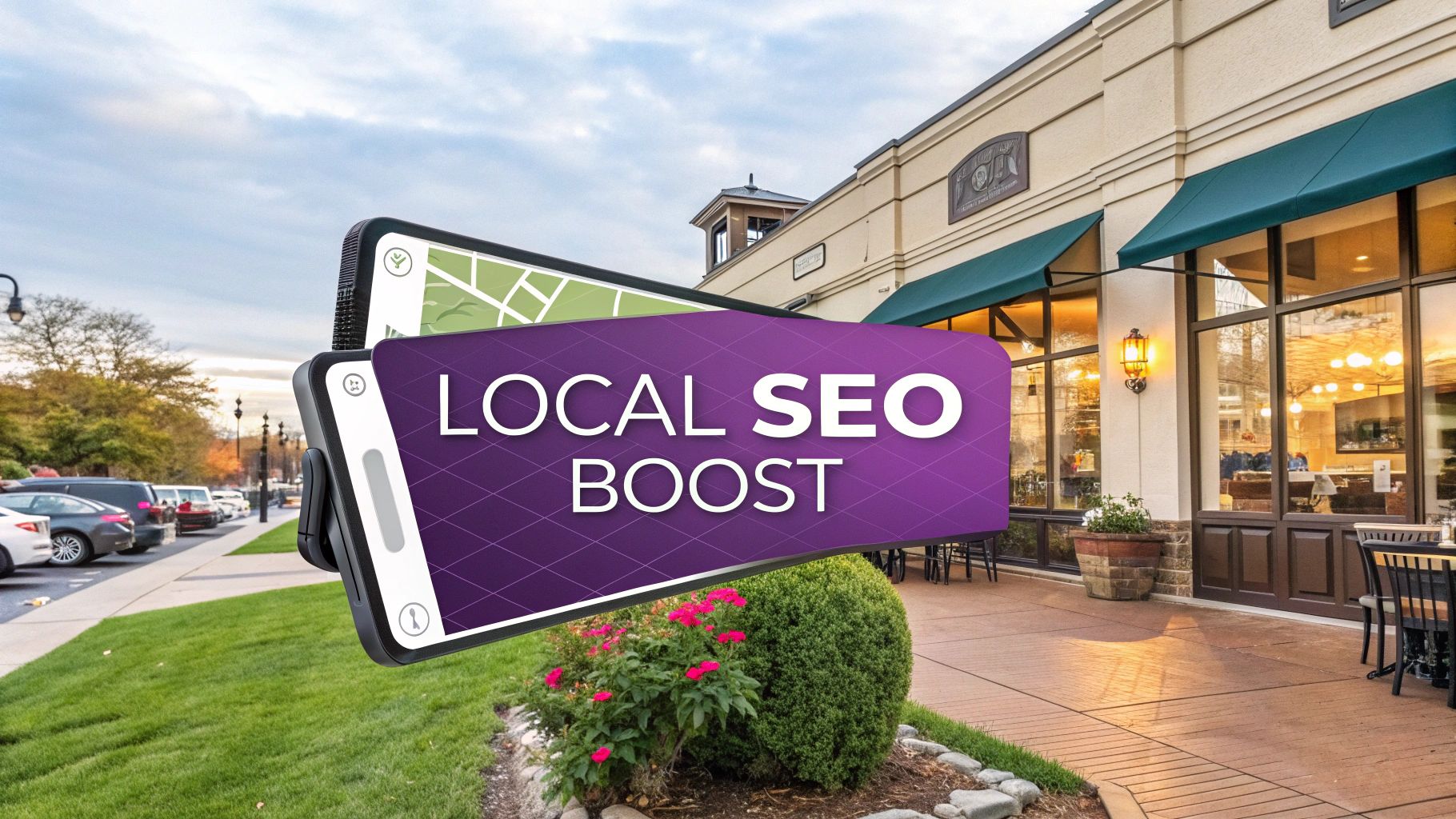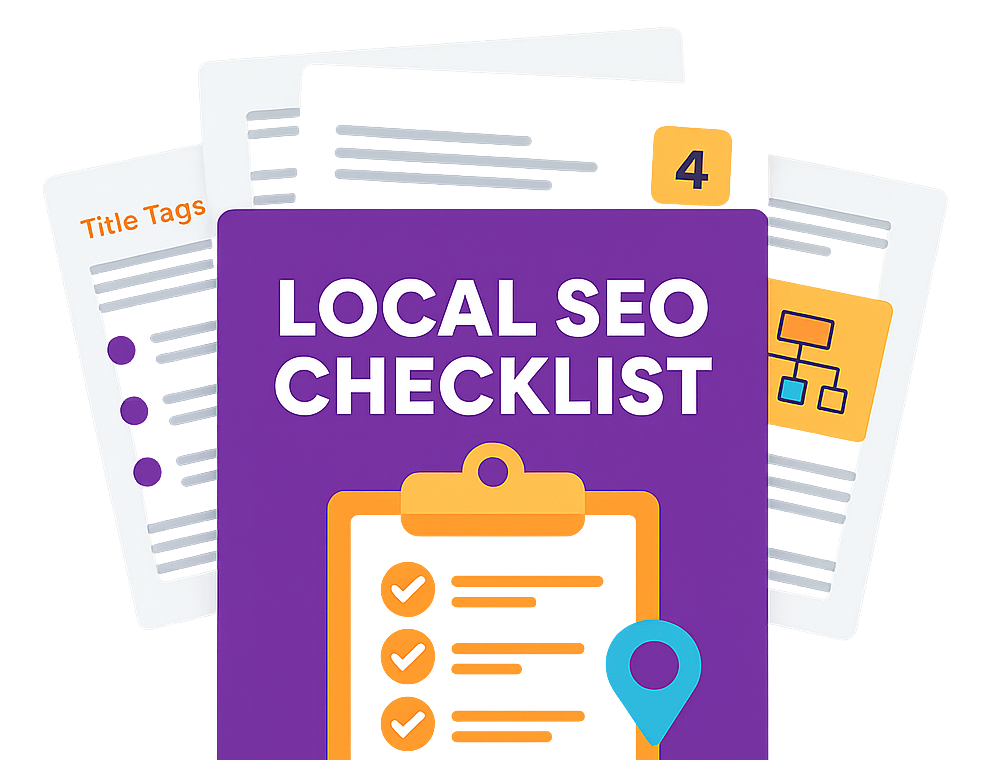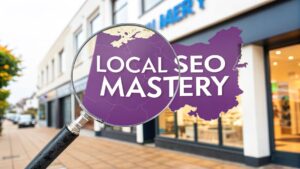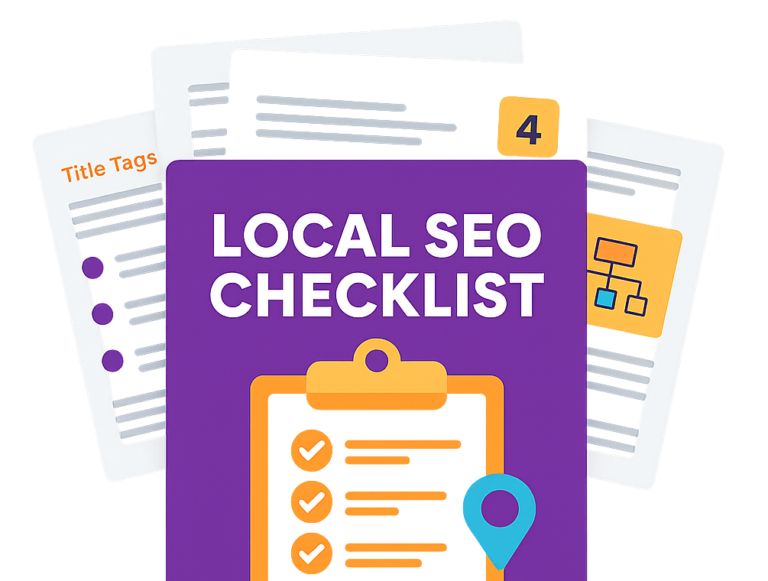Local SEO for restaurants is really just about making sure you show up when hungry people nearby are searching for a place to eat on Google. Think about it: when someone pulls out their phone and types "best Italian restaurant near me," you want your place to pop up right at the top, especially in the Google Map Pack. It’s all about turning those online searches into real-world customers walking through your door.
Why Local SEO Is The Secret Ingredient for a Full Restaurant
An empty restaurant is every owner's worst nightmare. In today's crowded food scene, the most important ingredient for keeping your tables full isn't just on the menu—it's how easily people can find you online. The days of relying purely on word-of-mouth are fading fast, replaced by the instant power of a smartphone search.

We've all done it: standing on a street corner, typing "best pub lunch near me" or "takeaway curry in Bristol" into our phones. That's the moment of truth for a modern restaurant. Showing up in those crucial search results is what directly translates into more bums on seats and more money in the till.
Connecting with Hungry Local Customers
Getting your local SEO right isn't just a box-ticking exercise; it's the most fundamental way to connect with diners in your neighbourhood who are ready to book a table right now. A solid local strategy ensures your restaurant isn't just found but is the one they choose over your competitors down the road.
This has only become more important as customer habits have shifted online. Digital marketing specialists focusing on local SEO for restaurants consistently see huge uplifts in client traffic and bookings by concentrating on these tailored techniques. It's proven: a smart strategy converts online lookers into actual diners. If you want to go deeper into the nuts and bolts, this comprehensive restaurant SEO guide is a great resource.
It all boils down to a simple idea: be visible where your customers are looking. To pull this off, your strategy needs to nail a few key areas:
- Google Business Profile (GBP): This is your digital front door. It’s where customers find your hours, address, menu, and reviews. A fully fleshed-out profile is your single most powerful local SEO tool.
- On-Page Website Optimisation: This means making sure your website's content and structure clearly tell search engines about your location, what kind of food you serve, and what makes you special.
- Online Reputation Management: You need to be actively managing and responding to customer reviews on platforms like Google, TripAdvisor, and Yelp. This builds trust and shows potential customers you care.
- Local Citations: This is about getting your restaurant's name, address, and phone number (NAP) listed consistently across relevant online directories to cement your location in Google's eyes.
Mastering these elements is no longer a "nice-to-have." It's the absolute core of a successful modern restaurant marketing plan, and it directly influences how many people discover your business and decide to eat with you.
This guide will walk you through how to master each of these components, step by step, turning your online presence into a machine that brings customers to your tables.
Your Core Local SEO Strategy at a Glance
To make it even clearer, let's break down how these essential pillars work together to bring more diners to your restaurant. Think of this table as your cheat sheet for a winning local SEO plan.
| SEO Pillar | What It Achieves | Real-World Impact for Your Restaurant |
|---|---|---|
| Google Business Profile | Puts you on the map—literally. It's your primary listing for local search results. | More phone calls for bookings, more requests for directions, and higher visibility. |
| On-Page SEO | Tells Google exactly what you offer and where you're located through your website. | Ranks higher for specific searches like "vegan pizza in Manchester." |
| Online Reputation | Builds trust and credibility with potential customers through positive reviews. | A potential customer choosing your 4.8-star rating over a competitor's 3.9. |
| Local Citations & Backlinks | Reinforces your location and authority across the web, boosting your relevance. | Appearing in "best of" local food blogs and directories, driving referral traffic. |
Getting these four areas right is the foundation for everything else. It’s a continuous effort, but the payoff is a steady stream of local customers who found you right when they were ready to eat.
Mastering Your Google Business Profile
Think of your Google Business Profile (GBP) as your restaurant's digital front door. It’s often the very first interaction a potential diner has with your brand, and when it comes to local SEO for restaurants, it's easily your most important asset. A neglected profile is like having a closed sign hanging on the door during opening hours; you’re just turning customers away.
Getting this right goes far beyond simply listing your address and phone number. A truly optimised profile acts as a dynamic hub that answers questions, shows off your best dishes, and convinces hungry searchers that your place is the place to be.
Nailing the Core Details
Accuracy is everything. It's the absolute foundation of a powerful GBP listing, and every single piece of information must be correct and consistent. Start with your primary business category—this is a critical signal to Google about what you do.
For example, if you run a tandoori house, your primary category should be 'Indian Restaurant'. But don't stop there. Get specific with secondary categories to capture more niche searches. You could add:
- Takeaway Food: Essential if you offer collection services.
- Cocktail Bar: Perfect for attracting the after-work drinks crowd.
- Fine Dining Restaurant: Helps you appear for searches related to special occasions.
- Vegan Restaurant: A must if you have a strong plant-based menu.
This level of detail helps Google match you with a much wider range of relevant customer searches, instantly broadening your reach. From there, make sure your opening hours, website link, and phone number are always up-to-date, especially around public holidays.
Crafting a Compelling Business Description
You have 750 characters for your business description, so think of it as your elevator pitch. This isn't the place for fluff; it’s a prime opportunity to weave in important keywords naturally while telling your story. Instead of saying, "We are a great restaurant," try something with more flavour.
Example: "Discover authentic Neapolitan pizza in the heart of Bristol's city centre. Our family-run Italian restaurant uses locally sourced ingredients to create classic pasta dishes and handmade sourdough pizzas, fired in our traditional wood-fired oven. Perfect for family dinners or a casual bite, we offer both dine-in and takeaway options."
This description naturally includes keywords like "Neapolitan pizza," "Italian restaurant," "Bristol city centre," and "takeaway," all while painting an appealing picture for the reader.
The simple infographic below breaks down the core flow of optimising your online content. It all starts with figuring out what people are actually searching for.

As you can see, effective optimisation begins with understanding your audience's search terms before applying them to your digital assets, like your GBP description.
Showcasing Your Restaurant with Photos and Posts
Let's be honest, diners eat with their eyes first. Your GBP photo gallery should be a mouth-watering collection of high-quality images. Upload professional shots of your signature dishes, the restaurant's interior ambience, the exterior, and even happy team members. It’s also a great idea to encourage diners to add their own photos, as this user-generated content adds a brilliant layer of authenticity.
Beyond static photos, Google Posts are a fantastic way to keep your profile fresh and engaging. Think of them as mini-adverts that appear directly on your profile. Use them to:
- Promote a weekly special (e.g., "Taco Tuesday – 3 for £10!")
- Announce a new seasonal menu.
- Highlight an upcoming event, like a live music night.
- Share a link to a recent blog post about your new wine list.
Regularly updating your profile with Posts signals to Google that you are an active, relevant business, and that’s a huge ranking factor. In fact, a well-maintained Google Business Profile continues to be a major factor in local SEO for restaurants, contributing approximately 19.2% towards local search ranking factors. Restaurants that maintain active profiles appear 2.8 times more frequently in the top three map results.
Engaging Directly with Customers
Your GBP is a two-way street. The Questions & Answers (Q&A) feature, for instance, is a goldmine for addressing common queries before a customer even has to pick up the phone. Get ahead of the game and populate this section yourself by asking and answering your own frequently asked questions.
- Q: Do you have gluten-free options?
- A: Yes! We offer gluten-free pasta and pizza bases. Please let your server know of any dietary requirements when ordering.
- Q: Is there parking nearby?
- A: There is on-street pay-and-display parking available, and the city centre car park is a five-minute walk from our restaurant.
- Q: Are you dog-friendly?
- A: We welcome well-behaved dogs in our outdoor seating area.
By managing this section, you control the narrative and provide helpful information that can easily sway a potential diner's decision. On top of that, enabling direct bookings and messaging through your profile removes friction, making it incredibly easy for a searcher to become a customer with just a few clicks.
For those looking to dive deeper, our detailed guide on Google Business Profile optimisation offers even more advanced strategies to help you stand out. This commitment to a complete, active, and engaging profile is what turns your GBP from a simple listing into your most powerful tool for bringing in new customers.
Turning Your Website into a Local Magnet
While your Google Business Profile acts as your digital front door, your website is your home turf. It’s the one online space you completely control, and it needs to scream 'local' to both potential diners and search engines. Getting your on-page optimisation right is what transforms your site from a simple online brochure into a powerful magnet for attracting local customers who are ready to eat.

This whole process is about fine-tuning specific elements on your pages to send crystal-clear signals to Google about who you are, what you serve, and—most importantly—where you are. It’s about making your website as helpful as possible for someone in your immediate area. Get this right, and you'll see a direct impact on how you rank for those all-important local searches.
Crafting Location-Specific Title Tags
The title tag is that blue clickable headline you see in Google's search results. Think of it as your first, and often only, chance to grab a searcher's attention. A generic title like "Our Homepage" is a massive wasted opportunity.
Your title tags must be descriptive, compelling, and include your location. This simple tweak makes a world of difference in attracting the right kind of clicks—from people who are genuinely close enough to pop in.
Here’s a quick look at what works and what doesn't:
- Bad: "The Golden Spoon"
- Good: "The Golden Spoon | Modern British Food in Bristol Harbourside"
- Bad: "Menu"
- Good: "Our Menu | Authentic Italian Pasta & Pizza in Bath"
See the difference? The better examples immediately tell a potential customer what you do, what kind of food you offer, and where to find you. That clarity is gold for both users and search engines.
The Unbreakable Rule of NAP Consistency
Your Name, Address, and Phone number (NAP) are the absolute cornerstones of your local online identity. It is absolutely crucial that these three pieces of information are displayed identically across every single page of your website, usually tucked away in the footer.
This consistency acts as a constant, reliable signal to Google, reinforcing your exact location and contact details. Any little variation—like using "St." on one page and "Street" on another, or having an old phone number on your contact page—creates confusion and can seriously dent your local rankings.
Pro Tip: Go one step further and embed an interactive Google Map on your contact page. It not only makes it dead simple for customers to get directions but also sends a powerful, direct signal to Google confirming your physical location. It's a small detail that builds a huge amount of trust.
Why Your PDF Menu Is Costing You Customers
One of the most common mistakes I see in local SEO for restaurants is uploading the menu as a PDF file. It might seem easy, but it's a disaster for search visibility. Google's crawlers can't properly read the text inside a PDF, which means none of your delicious dishes are being indexed.
Imagine someone searching for "vegan pizza near me." If your vegan options are locked away in a PDF, your website simply won't show up. You are effectively invisible to a huge chunk of your target audience.
The solution is simple: create a dedicated menu page using standard HTML text. This lets search engines crawl and index every single item, from your "Pan-Seared Scallops" to your "Chocolate Lava Cake." All of a sudden, your restaurant can start ranking for hundreds of specific, long-tail searches related to the food you actually serve. To make sure your website is firing on all cylinders, incorporating these best website practices for unstoppable growth is a must.
Creating Content with a Local Flavour
Your website is your chance to really celebrate what makes you a unique part of your local community. Go beyond just listing your menu and opening hours. It's time to create content that shows off your local roots.
Think about writing blog posts or creating pages about:
- Local Supplier Spotlights: Write a feature on the nearby farm where you get your seasonal vegetables or the local butcher who supplies your steaks.
- Neighbourhood Guides: Create a guide to the best things to do in your area, positioning your restaurant as a key part of the local experience.
- Event Partnerships: Document your stall at a local food festival or your involvement in a charity event.
This kind of content is naturally packed with local keywords and place names, sending powerful relevancy signals to Google. More than that, it tells a compelling story to your customers, showing that you’re an authentic, engaged member of the community. For a practical look at how these strategies come to life, you can explore our local SEO guide for ranking higher in Cambridgeshire. This approach turns your website from a static menu into a dynamic local hub.
Building Trust Through Citations and Reviews
While your website and Google profile are the online properties you own, what other people and platforms say about you often carries even more weight with potential diners. This is where off-page local SEO comes in, driven by two incredibly powerful elements: citations and customer reviews.
Getting these right helps you build a rock-solid online reputation that directly influences both your search engine rankings and, ultimately, a customer's decision to book a table. Think of it as the digital version of word-of-mouth. These signals tell Google and hungry locals that you're a legitimate, active, and trusted part of the community.
Cementing Your Location with Citations
So, what exactly is a citation? Put simply, a citation is any online mention of your restaurant's Name, Address, and Phone number (what we call NAP in the industry). You'll find these on local business directories, social media sites, food blogs, and online newspapers.
Each consistent citation acts as a small vote of confidence, confirming your restaurant's location and contact details. The more high-quality, consistent citations you have scattered across the web, the more certain Google becomes that you are who and where you say you are. This digital reassurance is a huge factor in climbing the local search rankings.
Consistency here is absolutely non-negotiable. Every single listing must match the NAP on your website and Google Business Profile down to the last letter. A tiny discrepancy, like using 'St' on one directory and 'Street' on another, can dilute the signal and confuse search engines.
Where to Build Your Citations
Don't panic—you don't need to get listed on hundreds of obscure websites. It's about quality over quantity. Focus your energy on the platforms that actually matter to UK diners and search engines.
Here's your priority list for UK restaurant citations:
- The Heavy Hitters: Your Google Business Profile and Bing Places are the top two. No exceptions.
- Key UK Directories: Make sure you're listed correctly on Yelp.co.uk, Yell, and Thomson Local.
- Food-Specific Sites: An optimised profile on TripAdvisor is essential for any restaurant. It's often the first place people look.
- Social and Local Hubs: Get listed on Facebook, Apple Maps, and even your local Chamber of Commerce website.
Building citations is a foundational task. It's not the most glamorous part of local SEO, but getting it right creates a stable base for everything else. A clean, consistent citation profile is a powerful signal of trust.
The Decisive Power of Customer Reviews
If citations build Google's trust, reviews are all about building your customers' trust. In the restaurant world, they're everything. Reviews provide the social proof that turns a curious searcher into a paying customer.
The stats back this up. A massive 90% of marketers agree that online reviews have a direct impact on how restaurants rank in local search results. And with 42% of users clicking on the Google Map Pack listings, you need every advantage you can get to land in that prime spot.
In fact, marketers estimate that Google Business Profile signals, including the quantity and quality of reviews, account for roughly 32% of what determines local pack rankings. This just confirms what every restaurant owner already knows: a steady stream of recent, positive reviews is one of your most powerful marketing tools.
Encouraging and Managing Your Online Reputation
You absolutely should be encouraging reviews, but you have to do it with a bit of tact. Never offer discounts or freebies in exchange for reviews—that's a big no-no and violates the terms of service for most platforms.
Instead, just make it easy and natural for happy customers to share their feedback.
- Give a gentle nudge. A small note at the bottom of the bill or on a tabletop card can be really effective.
- Train your team. When a customer has had a fantastic experience, staff can say something simple like, "We're so glad you enjoyed everything! If you have a moment, we're on TripAdvisor and Google and would love to hear your thoughts."
- Use your socials. Occasionally share links to your review profiles on Facebook or Instagram, thanking customers for their ongoing support.
Responding to reviews is just as important as getting them in the first place. You should aim to respond to every single review, good or bad. A glowing review deserves a warm thank you. A negative review is your chance to show everyone watching how seriously you take customer service. A professional response that offers to resolve the issue offline can win over more future customers than a dozen five-star ratings ever could. Mastering this is a core part of any successful campaign for small business local SEO.
Tracking What Works and Refining Your Approach
Local SEO isn't a "set it and forget it" task. Far from it. Getting your optimised Google Business Profile and website live is just the starting line. The real wins come from digging into the data, seeing what's actually resonating with potential customers, and tweaking your strategy over time. This is how you turn good results into great ones.
The good news? You don't need fancy, expensive software to get started. The free tools you already have—namely your Google Business Profile (GBP) Insights and Google Analytics—give you everything you need to make smarter calls on your local SEO for restaurants campaign.
Key Metrics That Actually Matter
It's incredibly easy to get lost in a sea of data. For a restaurant, you need to cut through the noise and focus on the numbers that translate directly into bums on seats. Your GBP Insights dashboard is the best place to start, as it shows you exactly how people are interacting with your listing in the real world.
Pay very close attention to these three actions:
- Direction Requests: This is a huge signal of intent. Someone asking for directions is very, very likely on their way to your restaurant.
- Phone Calls: These are your future diners. They're calling to book a table, check your opening hours, or ask about the menu before they commit.
- Website Clicks: This shows how many people wanted to dig deeper, maybe to browse your full menu or find your online booking system.
These aren't just abstract numbers; they are direct touchpoints with potential customers. Watching these figures month-on-month gives you a clear, honest picture of whether your optimisation efforts are actually working. For restaurants, online visibility often has a direct impact on foot traffic, which is why it's so important to track offline conversions.
Creating a Simple Feedback Loop
The whole point of this data is to create a feedback loop for continuous improvement. Just set aside a bit of time each month to look at what's happening and ask some simple, critical questions.
Let's say you see a 30% spike in direction requests after adding some fantastic new photos of your Sunday roast special. That's a clear win, telling you that content resonated. But what if website clicks from your profile have dipped? That might suggest your latest Google Post isn't compelling enough to make people want to learn more.
By connecting the dots between your actions and the results, you can stop guessing and start making data-driven decisions. If you notice lots of phone calls but no increase in bookings, it might highlight a problem with how your team is handling telephone enquiries.
This simple monthly analysis transforms your local SEO from a static checklist into a dynamic, responsive strategy. And to keep all the moving parts straight, a structured guide can be a lifesaver. You can learn more with our comprehensive local SEO checklist for businesses to keep your efforts organised and effective.
Got Questions About Local SEO? We've Got Answers
Even with a solid plan, it’s completely normal to have questions pop up about the finer points of local SEO. Here are some straightforward answers to the questions we hear most often from restaurant owners, designed to clear things up and keep you moving in the right direction.
How Long Does Local SEO Take to Show Results?
Patience is a key ingredient in any good SEO recipe. While optimising your Google Business Profile can bring some quick wins—like more calls or requests for directions in just a few weeks—building real authority and climbing the rankings is a marathon, not a sprint.
You should realistically expect to see a noticeable lift in your local search visibility and customer enquiries within three to six months. It's the consistent, ongoing effort of getting fresh reviews, building citations, and keeping everything up-to-date that really drives sustainable, long-term growth for your restaurant.
Do I Really Need a Blog for My Restaurant Website?
While you can survive without one, a blog is an incredibly powerful tool in your local SEO for restaurants arsenal. Honestly, it’s your best chance to create content that naturally hits important local keywords while telling your unique story.
A blog lets you connect with your community on a much deeper level. Think about writing posts on things like:
- Shining a spotlight on your partnership with a local brewery or farm.
- A guide to the best pre-theatre dinner spots in your neighbourhood (featuring your restaurant, naturally).
- The story behind your head chef and what inspires their cooking.
This type of content is a massive signal to Google that you're a vibrant, active part of the local community. Over time, that can give your rankings a serious and valuable boost.
Is a Perfect Five-Star Rating Better Than Lots of Reviews?
This is a classic dilemma, but the answer is usually pretty clear: a steady stream of recent, genuine reviews is almost always more valuable than a perfect but sparse rating. A high number of reviews shows potential diners that your restaurant is popular and busy right now.
A mix of four- and five-star reviews often feels more trustworthy and realistic to customers. The most important factor, though, is how you respond. Engaging professionally with all feedback, especially the negative comments, builds trust and shows off your customer service far more effectively than a flawless rating ever could.
Should I Pay for Listings in Local Business Directories?
For the vast majority of restaurants, the answer is a firm no. Your time and money are much better spent absolutely mastering the free, high-impact platforms first. Start by making sure your profiles on Google Business Profile, Bing Places, and TripAdvisor are perfectly optimised.
Some niche paid directories might look tempting, but you have to ask yourself if they’re genuinely relevant to your specific type of food or location. The absolute key is to make sure your Name, Address, and Phone (NAP) details are 100% consistent across every single listing you have, free or paid. Focus on consistency, not quantity.
Ready to turn local searches into loyal customers? At Bare Digital, we specialise in creating bespoke SEO strategies that help restaurants in Cambridgeshire and beyond dominate their local market. Get your free, no-obligation SEO Health Check today and discover how we can fill your tables. Find out more at https://www.bare-digital.com.








